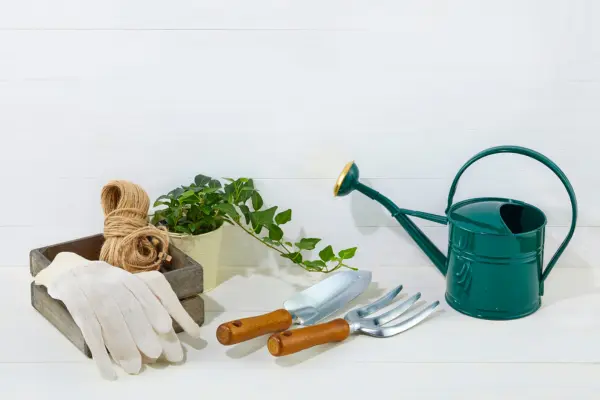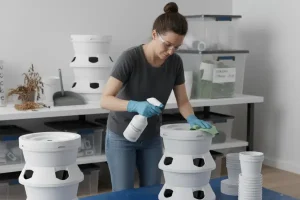Vertical gardens may be smaller than traditional ones, but they still require the right tools to keep plants healthy and tidy. Two of the most overlooked yet essential tools are garden gloves and pruning shears.
Whether you’re trimming herbs, deadheading flowers, or training climbing vegetables, these simple tools make your work safer, faster, and more enjoyable. In this guide, we’ll look at the best types of gloves and shears for vertical gardens and how to choose the right pair for your needs.
In tight vertical setups, comfort and control matter. Look for gloves with good dexterity for small pockets and delicate stems, plus a grippy palm for handling wet planters or slick trellises. Compact, sharp shears (bypass style for live stems, needle-nose for detail work) help you reach tight spots without crushing leaves or snagging irrigation lines.
If you use a step stool, gloves also protect your grip while you steady yourself. The right fit and blade style reduce hand fatigue, prevent accidental damage, and keep maintenance quick and stress-free.
Why Gloves and Shears Matter
- Garden gloves protect your hands from cuts, blisters, and exposure to soil-borne bacteria. They also give you a better grip when handling planters or climbing structures.
- Pruning shears help you trim plants cleanly, which encourages healthy regrowth and prevents disease.
In a vertical setup, where space is tight and plants are close together, precision and protection matter even more.
Choosing the Right Garden Gloves
Not all gloves are the same. The best pair depends on what kind of vertical gardening you do.
1. Lightweight Fabric Gloves
- Best for: Delicate work like planting seeds or pinching herbs.
- Pros: Breathable, flexible, inexpensive.
- Cons: Offer less protection against thorns or sharp edges.
2. Nitrile-Coated Gloves
- Best for: General vertical garden care.
- Pros: Good grip, water-resistant, protects against soil.
- Cons: Less breathable in hot weather.
3. Leather Gloves
- Best for: Roses, climbing vines, or plants with thorns.
- Pros: Durable, strong, excellent protection.
- Cons: Heavier, less flexible.
4. Waterproof Gloves
- Best for: Handling wet soil, cleaning reservoirs, or rainy-day gardening.
- Pros: Keeps hands dry, easy to wash.
- Cons: Can feel bulky.
Choosing the Right Shears
Vertical gardens often require frequent trimming to keep plants neat and encourage growth. Here are the main types:
1. Bypass Pruners
- Work like scissors with two curved blades.
- Best for: Live stems, herbs, and flowers.
- Clean cuts that heal quickly.
2. Anvil Pruners
- One sharp blade presses against a flat surface.
- Best for: Dead stems or woody branches.
- More crushing action, so not ideal for delicate plants.
3. Precision Snips
- Small, narrow blades for fine trimming.
- Best for: Herbs, strawberries, or compact flowers in tight spaces.
4. Ratchet Pruners
- Use a ratcheting mechanism for extra power.
- Best for: Gardeners with weaker hands or thicker stems.
Quick Reference Tool Table
| Tool Type | Best For | Pros | Cons |
| Fabric Gloves | Light gardening | Flexible, breathable | Less protection |
| Nitrile Gloves | Everyday use | Good grip, water-resistant | Warm in hot weather |
| Leather Gloves | Roses, vines | Durable, thorn-resistant | Heavy |
| Waterproof Gloves | Wet work | Keeps hands dry | Bulky |
| Bypass Shears | Live stems | Clean, precise cuts | Not for thick branches |
| Anvil Shears | Dead wood | Good power | Can crush soft stems |
| Precision Snips | Herbs, compact plants | Accurate, lightweight | Not for large stems |
| Ratchet Shears | Thick stems | Easier cutting | Slower process |
Care Tips for Gloves and Shears
- Gloves: Wash regularly, air-dry to prevent odor. Store in a dry place.
- Shears: Clean blades after each use to prevent disease spread. Sharpen every few months for smooth cuts. Apply light oil to prevent rust.
Common Mistakes to Avoid
- Using household scissors instead of shears – leads to jagged cuts and plant stress.
- Wearing gloves that are too loose – reduces dexterity and may cause accidents.
- Skipping blade cleaning – spreads diseases between plants.
- Neglecting to sharpen shears – dull blades tear instead of cut.
FAQs
Q: Can I use one pair of gloves for everything?
Yes, but having at least two types (lightweight and heavy-duty) makes gardening easier.
Q: How often should I replace gloves?
When they develop holes, lose grip, or no longer protect effectively.
Q: Are expensive shears worth it?
Yes, especially if you garden often. Quality shears last longer and require less effort.
Q: Can I disinfect shears with household cleaners?
Yes. A quick wipe with rubbing alcohol or a bleach solution prevents disease spread.
Next Steps & Related Reading
For tool setup, see DIY Mounting Systems: Brackets, Rails & Planter Hooks.
If you want year-round care routines, check How to Sterilize & Store Equipment Between Growing Seasons.
Conclusion
Garden gloves and shears may seem like simple tools, but they’re vital for vertical garden care. The right gloves protect your hands, while sharp shears keep plants healthy and thriving. By investing in these basics, you’ll make vertical gardening safer, easier, and far more enjoyable.
Would you prefer a lightweight pair of gloves for everyday use, or a durable leather pair for thorny plants?




